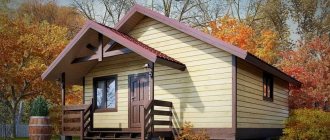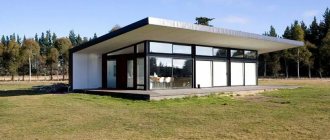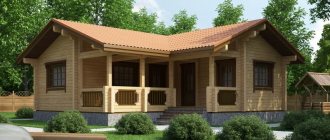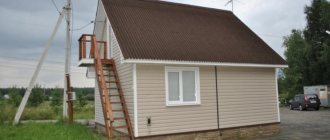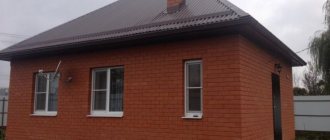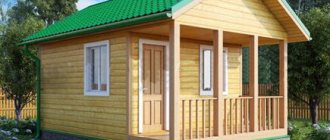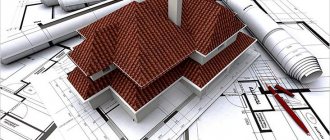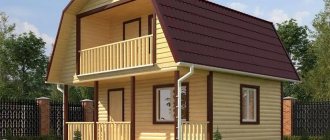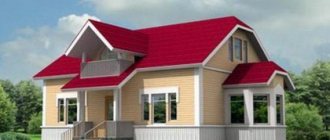In our difficult times, sometimes we want to take a break from the bustle of the city, breathe clean air, not polluted by fuel combustion products. If you own a country house, a dacha or, for now, just a plot of land, this means that you have the opportunity to spend a pleasant weekend in nature.
For a comfortable holiday outside the city, you need a comfortable home where absolutely everything is provided. Naturally, you will not be able to create all the conditions at once, especially if you have just purchased a plot where there are no buildings or are in a condition unsuitable for habitation. Capital construction may take many years. But at present, there are options that will allow you to quickly build a modern country house or dacha, and the project will include not only a house, but also several buildings. Agree, it is very convenient to have a bathhouse, a carport, a gazebo or a small terrace with a barbecue on your site, and if finances allow, a swimming pool and your own sports ground in front of the house.
At the design stage, some points should be taken into account: the area of the house, bathhouse, carport. These parameters will directly depend on the number of members of your family, on whether you are going to invite friends or relatives to visit, because you need to not only calculate the number of rooms, but also how many cars can be parked under the canopy at the same time.
There are many different projects that will combine a variety of building options. For example, it could be a house with an attached bathhouse or a bathhouse and a carport, which can be used as a firewood warehouse or gazebo. One of the most popular and convenient options is a house with a carport.
A house, a bathhouse, a shed - all this can be ordered from organizations involved in the design and installation of prefabricated houses or built with your own hands.
The materials used in construction are different, but the most common are houses made of timber.
If you decide to start building a house and a bathhouse and a canopy in front of them, you need to familiarize yourself with some aspects that are undoubtedly important during construction.
No. 1. Project of a garage for two cars with a bathhouse and a canopy
The project will be of interest to those who have 2-3 cars in their family or who often have guests in their own vehicles. True, you will need enough space for construction, so this option is not suitable for very small areas - the dimensions of the building are 12.23 * 13.37 m. Among the features of the project, we note:
- spacious parking space for two cars (area 50.4 m2). There is enough space to organize a storage system for firewood, necessary tools and even gardening tools
- Additionally, there is a carport where you can park a third car;
- the bathhouse part is isolated from the garage and has its own entrance through the vestibule;
- next to the sauna there is a shower room and a relaxation room (16.6 m2), where you can easily place a sofa, a couple of armchairs and a table;
- the project also provides for a boiler room with a separate entrance;
- total area – 84 m2.
The author of the project proposes to build a building from ceramic block (it is characterized by high strength, durability and thermal insulation qualities), finish the walls with plaster, and cover the roof with metal tiles. This solution is perfect for large families, as well as for those who like to spend time in a large company - there are more than enough parking spaces and space for relaxation.
Examples of finished structures
This is what a high-quality, solid bathhouse in a garage can look like. Almost all surfaces are made of smooth, light-colored wooden boards. A stone wall separates the steam room from the main part of the stove; only the container with the heating stones is brought outside. There is only one lamp - a diamond-shaped one, above the front door (which is lighter than the walls surrounding it).
Here is another example - with a stove located in the steam room itself. The walls around it are decorated with stone, the substrate is also made of stone, and the rest of the room is decorated in a more familiar way - with boards. The main structure is made in the form of steps; an imitation of a log house is used around the entrance door.
A visual representation of the bathhouse project in the garage basement can be seen below.
Often, owners of private households think about building a bathhouse and a garage on their plot. To save money, time and square meters of territory, you can build all these buildings under a common roof.
How to build it yourself
When planning the interior of a structure, it is not necessary to use a ready-made project. A self-prepared plan for a bathhouse-garage complex will allow you to take into account all individual features
When drawing up a DIY construction project, it is important to consider the following nuances:
- the wall between the two parts of the complex must have reliable waterproofing and thermal insulation;
- For greater reliability, it is recommended to install 2 walls between buildings, and between them it is worth providing a small storm drain.
The design process itself consists of the following stages:
- Drawing up a detailed plan. If you don’t have enough experience, it may be worth using a ready-made project and drawings.
- Selection of materials, including finishing.
- Choosing the type of foundation. Read more about the types of foundations and methods of their construction here.
- Selection of the type of rafter system and roofing material.
Also at this stage you need to decide on the size of the structure, internal layout and number of floors.
Specifics of operation of a pitched roof
Attention! Design should be carried out by specialists who know all its intricacies.
Many of us are not designers, but everyone who is thinking about construction should know about the specifics of drawing up projects and operating such a roof.
House made of timber with a pitched roof
- When the project does not have an attic, and the rafter system will be the basis for the ceiling of the upper rooms, it is necessary to select high-quality materials for roofing, waterproofing, and finishing. Otherwise, after the first leak you will have to spend money on repairs.
- It is necessary to make good thermal insulation, since a roof without a technical floor can freeze evenly over the entire area (read the article for the best way to cover and insulate the roof).
- If the project has a roof with a small slope angle, you will need to regularly monitor its condition and repair it in a timely manner. It is necessary to provide access paths to the top so that you can manually clear the surface of snow.
The greater the slope, the better
- The attic floor becomes an ambiguous room. The low part of the room should be given over to the installation of furniture (for example, structures with retractable storage spaces), and the remaining walls are made at the discretion of the owners.
If the roof has a large angle of inclination, the entire front wall is open to winds and showers, so protection should be provided.
Stages of drafting a project
It's time to start the most interesting part - drawing up a project for a garage with a bathhouse! A competent project is a guarantee of a beautiful and comfortable design. Therefore, approach its development extremely responsibly.
Drawing up a project includes the following stages:
- determining the type of structure - the construction of a new structure or the addition of an object to an already finished premises;
- Determining the contractor for the project work - searching for ready-made solutions, doing it yourself, contacting a specialist.
Difficult? No. Let's move on to the next point.
Project content
The project should include the following sections:
- planning in a suburban area;
- foundation type;
- walls;
- roof;
- internal arrangement of rooms;
- communications;
- finishing (external and internal);
- interior.
Layout
When constructing a new facility, the following are taken into account:
- size of the territory;
- presence of other buildings;
- location of trees and large shrubs;
- location of the entrance from an external road, well, communications, drainage pit, water intake stand;
- ease of passage from the erected structure into the house.
When adding an object to an existing premises, take into account:
- all of the above points;
- the possibility of installing a steam room on the second floor if there is not enough space on the site;
- side of the location of the attached structure.
Foundation
For a new building, the type of foundation is selected taking into account:
- depth of occurrence of GW (groundwater);
- soil composition;
- weight of the construction project;
- ease of construction of one or another type of basis.
Experts advise building a reinforced strip base.
Walls
Today structures are being built:
- from foam blocks;
- made of wood;
- made of brick.
Many builders do not recommend using wood to build a garage, as it ignites and deteriorates when exposed to exhaust gases. But it was like that before. Today, there are a lot of substances that make it indifferent to the harmful effects of aggressive factors.
Are you ready to regularly care for your fragrant raw materials? So, your choice is healing wood!
Do you want to enjoy the aesthetics and ergonomics of the design without the hassle? Your choice is a reliable brick.
Are you dreaming of a warm and beautiful bathhouse and garage complex? Your choice is a functional foam block!
Experts advise using foam blocks for a new construction project, and for an attached structure - brick and wood - timber or logs
In addition, professionals advise paying attention to the fact that a garage can be built from, for example, brick, and a steam room from wood. After selecting the material for the walls, a list of additional work is determined:
- façade painting;
- applying decorative plaster;
- finishing with siding, etc.
Roof
Both the attached structure and the new structure need a roof. For an extension, the roof structure is determined taking into account the pairing of the old and new walls. For a new facility, the roof structure is determined by the design of the entire structure.
Internal layout of rooms
The layout should take into account the location of:
- exit gates and inspection pit;
- passage from the bathhouse to the garage;
- cellar and utility block;
- furnace and water heater;
- sewer system;
- dressing room and steam room;
- washroom and rest room;
- toilet (if available).
Communications
Since the construction of this complex is carried out on a site where a house has already been built, it means that communications are available on the territory. In this case, the project must provide for connection to the following systems:
- water supply;
- sewerage;
- power supply;
- gas pipeline (if available);
- and don’t forget about ventilation.
Sheathing
Materials for finishing a bathhouse-garage are selected depending on the type of construction raw materials, taste preferences and financial capabilities.
Brick baths with kitchen or barbecue
Project with a kitchen and verandaProject with a glazed veranda
By the way, the stove can also be built from brick, but it must be ceramic. Silicate can also be used to build the walls of a bathhouse, since the masonry from the inside is still carefully insulated.
Project 3 by 6 with veranda
In most bathhouse projects with all kinds of extensions, a foundation is provided in the form of a slab monolith.
- Firstly, it is universal and can be poured on different soils (with the exception of weak unstable ones, when piles are required).
- Secondly, the stove is very convenient; you don’t have to fill the floors in the bathhouse itself or in the outdoor area where the terrace is located. You don’t have to calculate the foundation for a barbecue or a stationary grill.
- Depending on the project, the walls can be built either from hollow brick using well masonry technology, or from concrete blocks with external brick cladding (with stone finishing on the base).
- The façade is insulated with mineral wool, which is the only insulation material that has a high degree of vapor permeability.
Bath house with veranda
Note: the installation of a ventilation façade is important for this reason. No matter how hard you try, it is impossible to ensure 100% tightness of the walls, and some part of the steam will still get into the thickness of the walls
You just need to make sure he has the opportunity to get out. Therefore, both the insulation and the membrane on top of it must be vapor-permeable - but this only makes sense if there is a technological gap!
The principle of steam movement in a ventilated external wall
In some projects, plaster over insulation is provided as exterior finishing (warm plaster systems)
In this case, it is important that both the plaster and the facade paint have the same high vapor permeability as mineral wool. The choice of material for partitions is at the discretion of the customer, but it is better if it is red brick. The structures are insulated from steam on both sides.
Layout
The layout, as in any other case, depends on the size of the building in plan and the number of floors. Consider the option of a guest house with an attic measuring 8*9.37 m:
- Below there is a spacious open veranda to the bathhouse, which, if desired, can be glazed or a barbecue installed.
- The relaxation room in this bathhouse is not inferior in size to a full-fledged living room, which has a fireplace (suitable for winter use), a small bar, and a television area.
- There is also a spacious bathroom, although without a bath, and, in fact, bathing facilities (washing room and steam room).
Bathhouse with relaxation room and veranda
In the attic there is one large room with an area of 28.5 m2, which can be divided into two bedrooms. On the top floor there is a built-in balcony, which allows the person who spent the night in the room to come out in the morning to breathe fresh air. Everything is convenient and focused on a comfortable stay.
Layout with veranda, attic floor
Bathhouse designs with a large veranda may also include a one-story building. And why not, if the site allows it? And then, a bathhouse can easily do without bedrooms, and a small rest room may well be enough for the owners.
In the example below, the bathhouse does not have a toilet room. If there is a residential building next to it, then there is nothing wrong with that - in extreme cases, “conveniences” will have to be provided on the street. But when there is a toilet - and it can be combined with a washing room - it is much more comfortable.
6x4 plan with veranda
This is exactly the layout of a 6x8 bathhouse with a veranda and toilet that is presented below.
Bathhouse with veranda: 6x8 plan
Of course, similar layouts can be envisaged in any other house, not just a brick one.
Note: brick has an advantage over wood. A brick, especially a solid one, takes a long time to heat up, but retains heat for just as long. Brick fencing structures will last much longer than ever-wet wooden ones. And even if the construction turns out to be more expensive, this is then compensated for.
Garage project with utility room
Any construction cannot be carried out without a clearly defined project; a garage with a utility block is no exception. Thanks to a well-thought-out project, you can greatly simplify the construction process and calculation of materials. This building can be quite different; it can differ in size, wall thickness, ceiling height, placement and number of windows, and much more. In order to make your garage and the shed built for it comfortable, you need to think in advance about the location and availability of sockets, decide on the heating method, make high-quality lighting, make or buy racks and shelves in advance and place them conveniently. But this is not all that you need to think about, since a lot depends on the area in which you live, the dimensions of the car, personal preferences and other factors that you should take into account when choosing the type of construction.
You can do the project for this building yourself, and this option is quite good, since you can save some money without turning to expensive specialists for help. In order to make your own project, you do not have to spend a lot of effort, time and finances. In addition, you can make a project that will be convenient for you. However, before you start making the project, you should decide on the material for the walls.
If you have the financial means, then contact specialists in this matter who will make calculations efficiently and fairly quickly. The owners will not have to redo or doubt the quality of this project
Good specialists pay attention to the most inconspicuous details that you might otherwise overlook. It is for this reason that a structure designed by specialists will be reliable and of high quality.
Choosing a foundation
Since a timber bathhouse is a lightweight structure, it does not require a reinforced foundation. The only exception is the space under the stove. It is imperative to strengthen both the base and the floor in this place, otherwise the floor plane will sag and deform, which will negatively affect not only the stability of the stove structure, but also the appearance of the dressing room.
Among other things, you will need to choose a foundation based on the condition of the soil. Thus, for heaving soils, those foundations that are preferable for soil in normal condition may not be suitable.
You also need to pay attention to the depth of groundwater. If they are located higher than 2 m from the ground surface, then it is not worth making a monolithic foundation
In principle, the process of pouring the foundation does not require special knowledge, since the baths generally have a simple layout.
Tape
This type is one of the most common, since it is easier than others to do it yourself. The strip foundation is a strip of reinforced concrete, which has a slightly larger perimeter than the future bathhouse. The width of the tape can vary, but most often the indicator chosen is 10 cm wider than the wall. So, when using a beam with a width of 20 cm (typical), the foundation will be 20 + 10 = 30 cm. The positive point is that the construction of a strip foundation does not require a lot of materials. All you need is concrete, reinforcement and a wooden frame.
In the future, it is important to waterproof the base well, for which they use various raw materials such as tar. It is extremely important to make high-quality markings before starting to dig a trench and subsequent work
The location of the walls plays a decisive role here, so you can’t go wrong. And also, in addition, a kind of cabinet for the stove is made - this is a wider place that is completely filled with concrete. The cabinet is pre-reinforced, increasing its strength.
Pile
Pile foundation is a universal option. It is perfect regardless of the type of soil and groundwater level. All you need to do is pre-make or purchase piles and deepen them to the desired level. If you have no experience in construction work, then it is best to abandon this option. Beginners find it very difficult to strengthen the foundation of this type under the stove, since each specific case requires an individual approach.
The unspoken rule is the location of piles at the junctions of walls - corners. And also the piles should lie under the walls themselves. The distance between the piles depends on the number of storeys of the bathhouse and the estimated weight of the entire structure. It is best to choose a pile foundation in cases where the bathhouse is planned to be combined with a residential building. Thus, the entire structure will look cozier and more attractive, while the cost of constructing such a foundation will be low.
Monolithic
A monolithic foundation is the least versatile, but the easiest to implement. All that is needed is to dig a pit, install a frame and pour concrete. On the one hand, monolithic slabs are recommended to be installed on heaving soils to stabilize the structure. It is believed that the slab will gradually move along with the house, and the house itself will not move or deform. On the other hand, this solution cannot be called economical, since a lot of concrete mortar and reinforcement will be required.
To pour a monolithic foundation, you will need concrete that does not set immediately. Since Portland cement is mainly used for concrete mixtures, you will have to try to find the right one. The shortcomings don't end there. In addition, it will be necessary to take care of the presence of ventilation slots in the concrete base, otherwise it will crack and lose strength.
Ideas for different areas
In both a standard and a fairly small room, you can easily arrange a garage combined with a bathhouse or sauna. Each option with different parameters has its own characteristics that should be taken into account.
Small room
There are times when you have to do your best to save free space, and all the necessary zones must be placed in a building measuring 6 x 4 or 6 x 7. As a rule, in such situations, most of the space is separated into a garage where the vehicle is located.
Average
When there is a little more space, you can allocate free space for a full-fledged sauna. In this case, both shelving and fuel storage space will fit into the garage. There is room on the shelves for gardening tools and everything else that is used in the garden. A building of 10 x 4 meters is enough to create a place where you can both work and relax.
How to build a sauna in a garage - options and general rules
Going to the dacha is always an anticipation of fruitful work on the plot, and then a worthy reward in the form of barbecue, aromatic herbal tea, and, of course, relaxation in the steam room. But, unfortunately, not everyone has the opportunity to arrange a separate bathhouse on a small plot of land, but there is always a way out of the situation. You can make a sauna in the garage. Or rather, discover the abilities of an architect and designer and, using the advice from this article, slightly redesign the space, and as a result get a house with a garage and a bathhouse.
Where to begin
First of all, it is worth completely emptying the room intended for renovation of all things. Then a thorough sanitization should be carried out. It is necessary to clean all surfaces, as well as walls and ceilings. If there is an old window in the garage, then it is advisable to replace it with a new one - metal-plastic. Since the adjacent wall to the garage will be a bathhouse, it would be better if the buffer room for storing a car or garden tools was also insulated. This way the heat consumption will be less.
There are quite a few products on sale that protect against fungus and mold, and their use will not be superfluous. Over time, due to dampness and mustiness, favorable soil is created for the growth of all kinds of harmful bacteria. And with the advent of a source of constant moisture and heat, the number of colonies may increase, so preliminary impregnation with special compounds remains in the interests of the owner of the steam room.
Moreover, after such a general cleaning, you can objectively look at the volume of the room and competently plan the future bathhouse, made from the garage with your own hands.
Arrangement of drainage
Since there is always water in the bathhouse, the drain must be made according to all the rules so that the liquid does not stagnate.
The first stage of this action will be choosing a place where there will be a drainage hole for spent water. For those who already have a drainage system, and it runs somewhere near the place where they are building a sauna from the garage with their own hands, there will be no problems. The pit must be positioned so that it is lower than the place where drinking water is collected, so that dirty water does not get into the well.
After the hole is made, it is necessary to remove the drain pipe and direct it into the hole. If the bathhouse is intended to be used during the cold season, then it is worthwhile to approach its insulation thoroughly.
Sand is easily permeable, and the pipe will receive water over the entire surface, as it is equipped with receiving holes.
External and internal insulation
An important point, since the final result will depend on the quality of the materials used and the thoroughness of the work carried out when building a steam room in the garage with your own hands. And if you initially save on insulation, then later you will have to spend a lot of money on heating.
Insulation inside
For insulation from the inside, the following materials should be used in the written sequence:
Polystyrene foam 100 or stone wool 100. Vapor barrier. Attention! It is very important to place this material with the correct side to the foam so that its flow is directed in the correct direction. Next, special foil is laid on craft cardboard. The structure is secured with slats, because a gap of 5 cm is needed between the foil and the external finishing material. Next, the selected finish is secured
Next, special foil is laid on craft cardboard. The structure is secured with slats, because a gap of 5 cm is needed between the foil and the external finishing material. Next, the selected finish is secured.
This “thermos” can maintain the desired temperature for about 2 days.
Insulation from outside
If the house or garage where the future bathhouse will be located is not insulated, it is best to use special slabs for external insulation. Despite their high cost, they fully pay for themselves, as they really help save on heating costs. And on top of them you can already attach external finishing.
What to do on the second floor
It happens that when remodeling a room, there is enough space left and you can make a second floor. It is recommended to use this area as:
- a relaxation room, but the exit must be made directly from the bathhouse complex;
- guest room;
- dryer for medicinal herbs and vegetables.
In such a room it will always be warm, dry and cozy.
The first steam in a sauna built by yourself will reward all your hard work!
Choosing material
Traditionally, bathhouses (no matter with or without an extension in the form of a gazebo) are built from natural wood, so the complex under a common canopy should be made of wood. This material is convenient and easy to work with
For example, building a frame bathhouse with your own hands will take about 3-4 weeks (depending on the foundation and the speed of its hardening). What types of wood are best used for building baths?
First of all, this is a rounded log. In addition to its versatility (you can build anything from it), it will cost relatively little. This structure looks great both with and without an attached seating area. In addition, the material perfectly withstands temperature changes.
Sauna complexes made of wooden beams are very popular among owners of country houses. In addition to ease of use and low price, the timber smells pleasant, creating an atmosphere of real rustic comfort in the room. It is easy to work with even a beginner.
You can build baths not only from wood. Foam block is perhaps the most budget-friendly and weightless material, which even those who have never dealt with construction before can handle. However, a bathhouse made from such blocks must be well hydro- and vapor-insulated, and this is a job for professionals.
A brick bathhouse is a very solid, beautiful, reliable structure. Its only downside is the price. And, of course, the need for good vapor barrier.
Stone bath complexes are built to last “for centuries”; they will not be damaged by any misfortune, but the cost of such a structure may turn out to be disproportionately high. There is a way out - use stone for the exterior decoration of the building. It will be much cheaper and will look very beautiful.
Construction of a swimming pool as an extension to a home
Making a swimming pool or sauna in a house that is already in use will not be difficult if you take into account a number of features of these structures. The issue of space can be resolved by building an extension to the house.
Since the pool is a complex hydraulic system, great attention should be paid to the correct installation of the structure and its subsequent maintenance. Combined projects of this type are popular, since the installation of shallow bathtubs does not require special permission
The pool is sometimes an extension to the house
The main task at the planning stage is to create high-quality waterproofing. Since a high load on the walls will be created inside the room, it is the waterproofing layer that must withstand the applied pressure for several decades. In this case, the house design should involve year-round use of a swimming pool or sauna, which requires a constant supply of clean water, as well as additional space for service equipment.
You can swim in the rooftop pool even in winterBy arranging the premises in a separate extension, the risk of overloading the foundation of the house is reduced.
You can also choose a house project with a ground floor and a combined garage, swimming pool and sauna. But then you will have to strengthen the foundation and maintain the required height of the basement.
If desired, the house can be combined with a swimming pool and a garage at the same time
When planning a house with a built-in pool, consider:
- how deep the bath will be;
- what shape is the pool planned for?
- type of filtration system - skimmer or overflow;
- room decoration options.
Equally important when building a house with an attached garage, swimming pool or sauna is maintaining the required microclimate for each room with a ventilation system and heating.
Construction of a building
Building a bathhouse is not a long process. Therefore, this structure can be installed first and live there while the construction of the main residential building is underway. In addition, everything necessary for living can be provided at once: a small kitchen, sleeping places and a bathroom.
Project of a bathhouse made of logs 6x9 m
The terrace is usually made open, limiting the perimeter with only a small fence. However, you can completely isolate it by installing, for example, glazing. An interesting solution when constructing a terrace is a sliding glass wall, which allows you to combine the living room with the terrace.
A barbecue on the terrace will allow you to concentrate all the necessary elements of a comfortable stay in one place.
A sauna with a gazebo and barbecue (grill table, barbecue) would be an excellent solution
Stages of work
Step 1. Site preparation.
Step 2. Construction of a foundation (its type is determined by the type of soil, load, time allotted for the work and financial capabilities), which can be monolithic, columnar, strip or pile.
Step 3. Construction of a bathhouse frame with a terrace.
The process of building a bathhouse with a terrace
Step 4. Installation of the roof structure.
Step 5. Cladding the building and insulating it.
Step 6. Installation of the floor.
Step 7. Installation of the stove and chimney (it is not needed for the electric model).
Step 8. Interior decoration.
Step 9. Conducting communications.
Bathhouse project with attic and terrace
The most important question that needs to be resolved when starting work is what to build a bathhouse from, as well as a terrace for it. In addition, the purpose of the building imposes some additional requirements for both construction and finishing.
Materials from which a bathhouse and terrace can be made
The extension must fit harmoniously into the overall architectural ensemble. Often it is made from the same building material as the bathhouse itself. Or from a design that matches it. The choice may be influenced by: the dimensions of the future building, the place intended for its installation, the material aspect.
The material must provide a good microclimate in the premises. It requires high resistance to temperature changes and high humidity levels. The environmental aspect must also be taken into account. No harmful substances should be released into the atmosphere under the influence of steam.
A wooden bath has many advantages over a brick, block or sandwich panel
Most often, baths are built from wood. These can be logs or timber; frame structures are also popular, in which wood is combined with other types of materials
But when using wood, it is necessary to pay attention to its treatment from the effects of climatic factors, and also, using special impregnations, to increase the resistance of the structure to fire
Ceramic brick remains popular.
Wood-burning sauna project
This is interesting: Beautiful bathhouse designs - we reveal all the nuances
Project of a house and bathhouse under one roof with photo
The design of a house and a bathhouse under one roof is, first of all, distinguished by its convenience. If you don’t have to walk through the entire area to get to the bathhouse, swimming in winter brings only pleasure, without complications.
And in the autumn slush or during the rain after a bath, running home is not beneficial. This is a great solution if there are small children or elderly people in the house.
No less important is the fact that a bathhouse under the same roof as the house significantly saves space. Owners of a small plot of land will be able, without embarrassment, to afford a full-fledged home and a bathhouse with a veranda for relaxation.
When purchasing land plots, you can choose a project with a bathhouse and a house under one roof, leaving space for a garage and other outbuildings.
An undoubted advantage will also be savings in building materials and money spent on construction work. If a house is being built from scratch, a single foundation is built for the dwelling and bathhouse.
As can be concluded from the name of the project, the roof and one of the walls will also be common. Naturally, in this situation, the question of fire safety for the home arises.
When using such a construction scheme, it is worth considering fire protection especially carefully. First of all, the wood used in construction is impregnated with a special composition that prevents fire.
It is also worth paying attention to the conduction of electricity in the house and bathhouse. Everything, the heating system, the stove in the bathhouse, and the electrical wiring must be installed by specialists, and not by handicraft methods.
In addition to fires, you should also be afraid of high humidity, which is inevitable in conditions of a steam room operating at full capacity.
To normalize the humidity in the house and prevent mold from appearing on the walls, it is enough to properly organize ventilation.
You will get a house for a large family with the opportunity to take a steam bath if you choose a project with one roof for both buildings.
Requirements for houses combined with a bathhouse
As already mentioned, in order for the result of your construction work not to be disastrous, you must follow several rules. Fire safety and good ventilation are the first of them.
If the bathhouse project is part of a residential building, you should also consider the need:
- Creating a proper sewer system that drains water from the bathhouse. You can make one sewer pit for draining water from the house and bathhouse.
- Proper waterproofing of the bath complex. The bathhouse should not only be well ventilated, but also have insulating material in the wall structure that will protect the house from water.
- Use the same material for the construction of external wall surfaces. If you choose a brick for a house, then the outside of the bathhouse should be lined with brick.
There are two options for building a bathhouse and a house under one roof: the first is to use a pre-selected project and build buildings from scratch.
The second option is when a bathhouse extension is made to an already built house, covering it with a pitched roof - a continuation of the main roof.
In both cases, one of the walls will be adjacent to the house. Try saving money here. For example, you can make a single heating system, or combine a sauna stove with a kitchen stove to save fuel.
Modern designs of bathhouses combined with a house have three combination depth options:
- Bathhouse on the ground floor or in the basement of the house. Such a project can be implemented exclusively at the stage of developing a construction plan.
- The independent construction of the bathhouse consists of four walls, one of which is adjacent to the wall of the house. In this case, one of the sides of the roof is simply extended.
- The bathhouse and the house have a common wall. In this case, you can make an entrance to the bathhouse directly from home. Waterproofing and ventilation are much more important here than in the previous version.
By the way, it is easy to make a transition from the house to the bathhouse, if it needs to be done across the street, with the help of a gazebo corridor. If you glaze it and provide heating, it will become a full-fledged recreation room.
Building a bathhouse under the same roof as a house is not too different from building it separately from a home. You can choose a free bathhouse project and begin construction.
Use a strip foundation for construction - it can withstand heavy loads and will not sag for a long time.
Wood is traditionally used as a material for walls. It allows air to pass through as much as possible, without creating a greenhouse effect inside the bathhouse and a microclimate favorable for the development of putrefactive bacteria.
When you build a roof over a bathhouse, remember that it also needs thermal insulation. This is especially true for bathhouses that are connected by a roof to a residential building.
If steam penetrates unhindered under the roof, the roof will soon require major repairs.
Construction of a building
As a rule, a veranda under the same roof as a bathhouse is planned at the project stage, and the materials chosen for it are the same as for the bathhouse. But this is not a prerequisite - one common roof and foundation is quite enough, but the veranda itself can be, for example, wooden against the backdrop of a brick bathhouse building.
Another option is an extension to an already finished bathhouse, for example, in a situation where the roof of the bathhouse building requires repair and replacement. When planning to change the roof, you can at the same time expand the bath space by adding the construction of a veranda to the project.
Foundation for the veranda to the bathhouse
Laying the foundation is the most critical moment of construction, on which the durability of the structure depends. Work on laying the foundation begins with determining the groundwater level and the degree of soil heaving.
The foundation for a veranda and bathhouse can be of several types.
- Belt is the most economical option, suitable for stable soil, and can withstand heavy structures well. The installation process consists of creating a trench around the perimeter of the proposed structure, installing simple formwork from scrap materials, laying a reinforcing frame and pouring a concrete mixture. After the concrete has completely hardened, you can begin building the walls.
- Columnar. Ready-made concrete blocks or pillars of bricks are dug into the pit prepared in advance. A “cushion” of crushed stone and sand is lined at the bottom of the pit, the pillars are compacted tightly, and the lower part of the pillars is filled with bitumen mastic. The pillars must be at the same height and stand no further than 2 meters from each other. The space between the pillars is filled with crushed stone. Next, as in the first case, concrete is poured.
Pile. This method is suitable for problematic soils with high groundwater levels. Wells are drilled at the points planned by the project, waterproofing is laid in the form of a roofing felt cone, and concrete is poured. On the surface, the piles are connected to each other by a grillage - a reinforced concrete frame.
Pile-screw. Another simple method involves screwing metal pipes with screw threads on the tips into the soil
It is important that the pipes are coated with an anti-corrosion compound.
Floors
The subfloor is laid on a completely dry concrete base. It is best to use wood with a deformation gap, since this material tends to expand due to temperature changes.
When choosing a finished floor covering, you should pay attention to wear-resistant, frost-resistant and non-slip materials. The bathhouse is heated only during certain periods, and in the winter season it is subject to freezing
Ordinary wood can crack in cold weather, and tiles are not always suitable for baths due to increased slipperiness. The best option would be to choose lining or decking boards made from a certain type of wood, already treated with special compounds.
For open terraces, larch or pine wood is usually used. Thanks to its resinous properties, it does not rot or lose strength, which significantly extends the life of the floor. Combined options based on wood and polymers are also available for sale.
Walls
The frame of the veranda is erected on a ready-made foundation and can consist of various materials: prefabricated metal profiles, timber beams, foam blocks, building bricks. The choice of material largely depends on the type of veranda itself. For an open type, a light wooden frame is sufficient, but a closed, warm structure will require solid walls and insulation.
Verandas are often glazed to the maximum or protected from wind and drafts with transparent polycarbonate. Window openings can completely replace walls in the manner of “French windows” from floor to ceiling, or be partially erected, for example, starting from the railing at waist level. An interesting option is to glaze part of the openings with stained glass mosaics. This gives the veranda an original look and protects from the direct rays of the summer sun.
Porch
The dimensions and height of the porch will depend on the height of the veranda flooring. The porch can be made of wood, brick or concrete. Sometimes forged metal products are used to decorate railings.
Projects
The main advantage is that when a garage and a bathhouse are built under the same foundation and roof, each person’s projects can be completely individual. The developer is free in his fantasies and can only be restrained by a small area of the site or insufficient funds.
Combined buildingSource pingru.ru
Bathhouse with parking
There are times when a builder is prevented from realizing his dreams by circumstances. For example, financial. The cost of materials may deter you. Or there are difficulties in isolating rooms from each other. Then you have to sacrifice one of the buildings, but not completely. Simply, instead of a permanent garage, you can attach a comfortable parking lot to the bathhouse.
In this case, you can build a classic wooden bathhouse and, in the same style, equip a nearby parking lot for a car, the roof of which is supported by wooden columns.
This will protect the car from bad weather and direct sunlight. Source makemone.ru
Garage for two cars and sauna
This is a project for people who are not strapped for money and do not save every meter of the site. Near the house you can build a spacious garage for two cars and a beautiful, comfortable sauna. For ease of departure and arrival, two gates are installed. They also allow you to save heat during the cold season. And the entrance to the sauna is located on the other side of the building.
This allows you to slightly isolate the bathhouse from the garage, creating a separate place for a good rest with friends.
To do this, the building can be equipped with a terrace, placing comfortable chairs or sun loungers on it. Source hi.decorexpro.com
Two-story building
This option is suitable for a developer who is not short on funds. But he has to save every meter of territory. On the ground floor there is a spacious garage with wide gates, and the bathhouse moves to the second floor. If you expand the seating area with a balcony, you can also get a small terrace.
Even on a very small area of the second floor there is enough space for a stove with a steam room, a shower and a dressing room for changing clothes.
If you use expensive elements when decorating a room or building, then even for a small building you can achieve monumentality. Source ep-stroy.ru
Projects with extended functionality
If nothing interferes and there is a desire, then you can expand the functionality of the building. A bathhouse with a garage under one roof can turn into a small utility complex. The design can be supplemented with a mandatory storage room for garden tools and various materials. This will allow the garage to be used only for its intended purpose, which will please many car enthusiasts who do not like to litter their favorite territory.
The main highlight of such a structure will be the equipment in one of the summer kitchen areas. This will completely transform the entire recreation area into a full-fledged guest house.
In the video you can see a garage and a bathhouse under one roof:
It must be admitted that such projects deserve not only recognition, but also close attention. After all, turning your fantasies into reality is not difficult. To do this, you need to take into account the recommendations of experts, do not forget about various nuances and apply sufficient persistence to a creative approach.
Material for construction
It is generally accepted that if a bathhouse or barn is being built, it is most profitable to use wood.
Wood has a number of advantagesSource market.sakh.com
It has a number of advantages:
- Because this material breathes, it is less vulnerable to moisture and fungal infestation.
- Wooden rooms provide better air circulation.
- Wooden beams and boards have their own pleasant odor when exposed to hot temperatures typical of a sauna room, this odor intensifies even more.
- If you use coniferous trees for wooden building materials, their aroma will have an additional healing effect.
In the video you can see a utility block with a bathhouse:
Pros and cons of combination
Country and suburban areas are always arranged in such a way that nothing reminds of urban overcrowding and monotony. Therefore, they try to save space by all means. It is for this reason that a garage with a bathhouse under one roof is such an attractive move for most landowners. Another important advantage is the ability to use one stove to heat a bathhouse and a garage at the same time. But to realize such an advantage, you will need to make a competent project.
In many cases, one or another part of the garage is given over to storing fuel (usually firewood); if suddenly they run out during bath procedures, you can take new ones in a warm room, without going outside. This is not only convenient, but also allows you to avoid sudden hypothermia with subsequent bronchitis and similar troubles. Some owners equip their bath complexes with attics, then everything becomes even more convenient.
There are also less obvious advantages, such as the ability to take a shower after dirty work on the car with minimal effort, without going far.
As for the problems, in addition to complicated waterproofing, you will have to thoroughly work on thermal protection; the choice of materials suitable for such contradictory premises is somewhat limited. But such difficulties will not stop responsible owners!
Frame extension: do-it-yourself step-by-step installation
Whatever the structure of the walls of the bathhouse, whether they are made not only of wood, but also of blocks or bricks, the veranda most often has a frame structure, it is easy to attach it to an existing building. A veranda attached to a bathhouse with your own hands will not only be a convenient place for relaxation, but will also make the building more attractive.
Option with attached veranda
Brief instructions in pictures will tell you how to do this:
| Photos, steps | A comment |
| Layout of extension axes | The location of the extension must be marked by driving in pegs and tensioning the twine. Since the foundation will be columnar, you need to draw all the contours of the holes for the pillars on the ground with a shovel. |
| Excavation for pillars | When constructing a shallow foundation, the bottom row of blocks is buried only halfway (15-20 cm). When digging holes, you need to add to this size the thickness of the drainage pad made of crushed stone and sand (at least 10 cm). This way the blocks will never get wet in water, because concrete doesn’t like that. |
| Laying crushed stone | Cover the hole with a piece of geotextile and fill it with crushed stone. |
| Tamping | You can tamp it in any way possible - you can do it as in the photo. |
| Laying sand | Now pour sand. There is no need to lay out the entire volume at once - after all, you need to level the base, adjusting its height to the desired level. |
| Determining the elevation of the top of the foundation | Mark the top of the foundation on the peg as a guide. |
| Sand bed compaction | Compact each layer of sand well, measuring the desired height to the mark. |
| Checking the horizontality of blocks | Wrap the ends of the geotextile inside the backfill, place the two lower blocks on them and check the horizontality with a level. |
| Mixing glue | In this case, foam blocks are used to lay the pillars, so not ordinary masonry mortar, but special glue is used. They can also be used to install polystyrene concrete blocks. |
| Applying glue to blocks | First, the surfaces of the vertical joints of the blocks are coated with glue, then the horizontal ones. |
| Laying the second row of blocks | The second row of blocks is laid out. |
| Installation of the bottom trim | When all the pillars are ready, a piece of roofing material is placed on each one so that the beam does not come into contact with the concrete. A frame is made around the perimeter of the veranda and floor joists are installed. |
| Pairing the stand with the harness | The racks are attached directly to the framing beam, secured with angles, staples, miter bars and other methods common in construction. The racks are also tied with timber along the upper perimeter. |
The frame is ready, the roof remains
Then it’s a matter of technology: the roof rafters and roofing material are installed, the floor is sheathed, crossbars and window frames (if the veranda is closed) or decorative fences are installed.
Frame for a closed veranda
Such a veranda or terrace can be attached to a brick or block bathhouse.
Summer veranda with climbing plantsOpen terrace with canopy
Projects of houses with a bathhouse and a garage - design features
Since personal plots are most often characterized by small sizes, home craftsmen use a variety of tricks to “squeeze” a maximum of functional buildings into a limited space. This is how projects of one-story houses with a garage and a bathhouse are created.
Everyone knows that a garage, a bathhouse and a residential building are buildings with completely different requirements and features. Therefore, they should be combined correctly, taking into account all the nuances that are characteristic of these buildings. We will talk about the features that house designs with a sauna and garage have in this article.
House with garage and bathhouse.
House design and preparatory work
First of all, you need to clearly establish the boundaries of your plot, check the correctness of the paperwork, and familiarize yourself with the document that lists all the building structures on the dacha plot, as well as the principle of their construction. This is necessary in order to know what exactly can be built on your plot of land. Typically this list includes: a residential building or cottage, a bathhouse or shower, a garage or carport, greenhouses and a summer kitchen.
Another important requirement is compliance with fire safety regulations. It is also necessary to comply with the requirements and standards of sewerage and drainage, gas supply, water supply and much more. To do this, you should familiarize yourself with building codes and regulations. At first glance, it may seem that the requirements are too high, but compliance with all standards guarantees the safety of your family and neighbors.
Preparatory work includes laying out communications and leveling the terrain. It is possible to carry out such work independently or to involve professionals. Everything will depend on your skills, financial capabilities, as well as your desire; it is possible that you want to carry out all the work yourself.
Advantages
The main advantage of combined buildings under one roof is the financial side. An extension to a previously constructed premises allows installation to be carried out much cheaper than constructing a new structure from scratch. If there are no structures on the territory, the construction of a separate common block that connects several rooms with different functional purposes is also a more profitable option.
An important advantage is that as a result of combining buildings, the owner has at his disposal a convenient building where he can simultaneously perform household tasks (storage of solid fuel that does not deteriorate under the influence of moisture, and others). Also, in combined buildings it is possible to use a comprehensive network of engineering communications and install a common heating system.
Peculiarities
The first enemy of any car and motorcycle is water. The garage may be cold, but it must reliably protect the vehicles parked there from precipitation. When installing a bathhouse inside or in an adjacent room, measures will have to be taken to ensure that moisture and vapors do not enter the main space, thereby not creating unnecessary problems. Another difficulty may be insufficient space: both the bathhouse and, in fact, the garage are always trying to be larger, but here you will have to find a compromise.
One more point: you will need to orient the building so that you can comfortably enter it from the house on one side and drive a car on the other.
